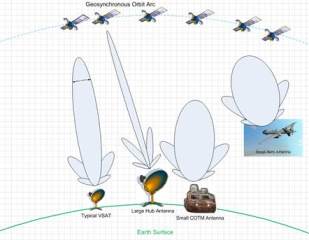The Practical Do’s and Don’ts of Mitigating Satellite Interference – Step-by-Step Actions End-Users Can Take
Satellite interference is one of the most persistent issues facing both satellite operators and end users because it can degrade or disrupt service. As more and more information services come to depend on satellite connectivity, satellite communications (SATCOM) has never been more vital.
In the military arena, interference sometimes can be caused by adversaries, who are intentionally trying to disrupt the satellite signal that provides forces with critical situational awareness and other information in theater. However, most satellite interference has more prosaic origins, and can be prevented or mitigated by operators and end users.
In any operational environment, low levels of cross-polarization interference (XPI) and/or adjacent satellite interference (ASI) are always present. These levels are accounted for in link budgets, and thus have little impact on service quality. Satellite operators such as Intelsat General (IGC) work to minimize all interference, and are especially concerned about detecting and eliminating harmful levels of interference that may disrupt customer services.
IGC utilizes an array of ground antenna systems connected to digital signal processors and remote spectrum analyzers to monitor signal levels on satellites and transponders. Advanced software compares received carrier signal levels, center frequencies, bandwidths, and modulation parameters to a database of nominal values. If a monitored carrier goes out of limits, the system alerts a technician to begin further analysis.
When the network detects an interference event, technicians first check for scheduled activity on adjacent frequencies and transponders in case there is an error in setting the frequency or the polarization. At the same time, the satellite operator sends out a “bogey message” requesting users of the affected satellite to check their equipment while technicians start geo-location of the source in case the cause is less obvious. Geo-location uses a comparative analysis of signal arrival times, phase, and frequency shift between adjacent satellites to determine the location of the source on the Earth’s surface — sort of like a GPS in reverse.
If that doesn’t locate the source of the interference, the IGC Secure Operations Center (ISOC) or RF Operations Center (ROC) may direct users to briefly mute their uplinks one by one in order to rule out terminals until the source is found. It is important for customers to provide accurate antenna registration information for each of their terminals as it helps to narrow down the number of terminals in the search area, or “ellipse,” in these types of situations.
In the event of ASI, operators of the adjacent satellites may work together to move sensitive users to other transponders to lessen the impact of interference. They also can adjust access procedures, power levels and transponder settings to reduce interference and ensure that users are not exceeding coordinated power density limits.
End users themselves can do a number of things to prevent interference, the most important of which is to follow proper satellite access / de-access procedures.
Users should always contact the ISOC whenever a terminal is activated or deactivated, especially if it is disassembled or moved between access attempts. The ISOC will help the terminal operator determine if “peak & pol” (pointing and polarization) are correct in order to prevent XPI and ASI, and will observe the signals on a spectrum analyzer in order to help set power levels correctly. Users should not attempt to transmit until authorized to do so by the ISOC.
Another best practice is having terminal installers take the Global VSAT Forum (GVF) basic VSAT installation course, or some kind of similar training. This is often cheap insurance against a potentially costly interference event. Severe or repeat interferers who don’t take such common-sense steps can be banned from operating or even fined by the U.S. Federal Communications Commission or other national authorities.
Users should double check assigned carrier center frequency, power level, modulation, coding, and data rates when configuring modems. They should also be sure that the up-converter local oscillator (LO) frequency is set correctly on the modem, because if it is not, the intermediate frequency (IF) translation will be incorrect. If that happens, the carrier will turn up on the wrong frequency on the satellite.
Intelsat definitely recommends using high-quality, well-shielded IF cables. Users should also inspect installed cables, connectors, and patch fields for damage or missing terminations, and replace when needed.
Another best practice is always muting the uplink chain or pointing the antenna away from the satellite arc when testing or performing off-air maintenance. This sounds simple enough, but some of the worst interference incidents in recent times were caused by technicians performing fiber inter-facility link (IFL) transceiver alignments while a hub terminal was left on the air.
If a terminal supports multi-carrier operation (more than one modem at a time), the user should make sure that its IF chain is operating in the linear region and is not in compression or saturation. Additional tests can be done using a spectrum analyzer or power meter to verify linear operation and find the 1dB compression point. (Your satellite operator will gladly assist if needed.) Linear operation is very important to avoid generation of intermodulation products and wideband interference.
Using the right-size terminal for the application can prevent a lot of problems. Antennas smaller than one meter in diameter present unique challenges and increase the risk of both causing and receiving ASI. This is particularly true of mobile terminals, which are difficult to point accurately during sudden vehicle maneuvers.
That probably sounds like a long list, but as with so many other things in life, an ounce of prevention is worth a pound of cure. By working together, satellite operators and end users can mitigate or even prevent the large majority of interference problems. With so many critical services riding on SATCOM, that’s a comforting thought this holiday season.
For any additional information or questions please contact me directly at 301-571-7697 or at stephen.jackson (at) intelsatgeneral.com.






















